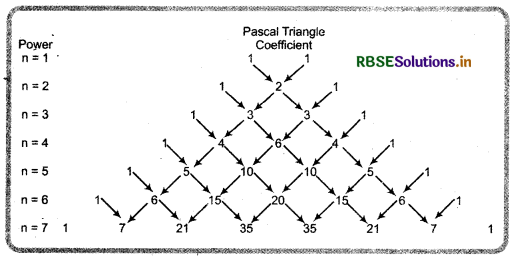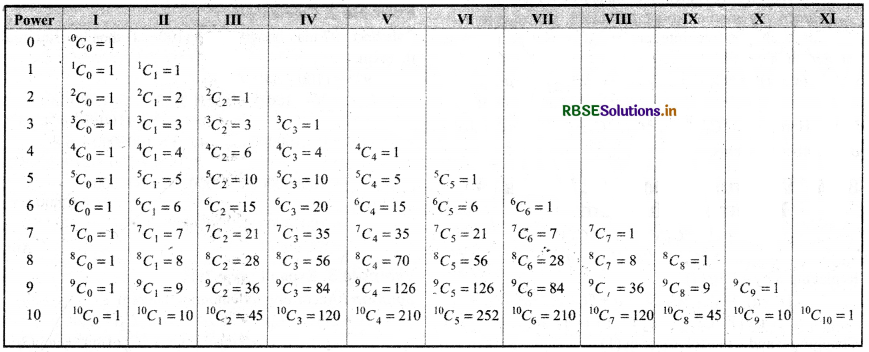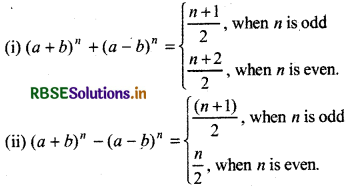RBSE Class 11 Maths Notes Chapter 8 Binomial Theorem
These comprehensive RBSE Class 11 Maths Notes Chapter 8 Binomial Theorem will give a brief overview of all the concepts.
RBSE Class 11 Maths Chapter 8 Notes Binomial Theorem
Introduction:
We have already read square and cube of expansions of Binomials as :
- (a + b)2 = a2 + 2ab + b2
- (a - b)2 = a2 - 2ab + b2
- (a + b)3 = a3 + 3 a2b + 3ab2 + b3
- (a - b)3 = a3 - 3a2b + 3ab2 - b3
The ancient Indian mathematicians knew about the coefficients in the expansion of (a + b)n in third century. The arrangement of this coefficients was in the form of a diagram called meru-prastara provided by Pingla. In sixteenth century, Bombelli also gave the coefficients in the expansion of (a + b)n, n < 7 and Oughtred gave them for n = 1, 2, ............... 10 in the starting of seventeenth century.
After this the triangle, popularly known as ‘Pascal’s triangle was constructed by the French Mathematician Blaise Pascal, which is of the following type :

In Pascal triangle each row start and end with in the beginning and the end numbers lie on same distances are equal. Any number of any line is obtained by adding those two numbers of previous line which lie on left and right side of number. Each row bounded by 1 on both side.

Binomial Expansion:
Any algebraic expression with two terms is called binomial expansion or only Binomial. Two terms are joined by positive or negative sign.
For Example :
(i) x + a, here x is first term and a is second term.
(ii) x2 - 9 etc.
Binomial Theorem: The formula by which any power of Binomial expression is expanded in the form of a series is called Binomial Theorem. Binomial Theorem is used to expand binomial expansion.
Binomial Coefficient: In the expansion of Binomial expansion (x + a)n, coefficients of different powers of x are called Binomial coefficients.
Similarly, It can be extended for more powers.
Coefficients of Terms of Binomial Expansion
 In the expansion of Binomial exponents, to write coefficient of terms, symbol of combination nCr is used, as given in above table. If we expand (a + b) for power 8 then in (a + b)8 coefficient of 4th term according to table = 8C3 = 56.
In the expansion of Binomial exponents, to write coefficient of terms, symbol of combination nCr is used, as given in above table. If we expand (a + b) for power 8 then in (a + b)8 coefficient of 4th term according to table = 8C3 = 56.
Thus, in (a + b)n coefficient of (r + 1)th term = nCr Term of its expansion can be seen from above table.
In more generalised form, Binomial expansion of (x + y)n can be written in following theorem form, where n is a positive integer.
Binomial Theorem for Positive Integer n
(x + a)n = nC0 xn + nC1 xn-1a + nC2 xn-ra2 + .... + nCr xn-r ar + .... + nCn an
Mathematical Analysis
Proof : We will prove this theorem by mathematical induction
(x + a)1 = x + a = 1C0x1 + 1C1 x1-1a .............(1)
(x + a)2 = x2 + 2ax + a2 = 2C0x2 + 2C1 x2-1a + 2C2x2-2a2 ..........(2)
From (1) and (2), it is clear that theorem is true for n = 1 and 2. Let theorem is true for +ve Integer m.
Then,
(x + a)m = mC0xm + mC1 xm-1a + mC2 xm-2a2 + ... + mCr xm-r ar + ...+ mCm am
Multiplying both sides by (x + a)
(x + a)(x + a)m = (x + a) [mC0xm + mC1 xm-1a + mC2 xm-2a2 + ...+ mCrxm-r ar + ... + mCm am]
(x + a)m+1 = x[mC0 xm + mC1 xm-1a + mC2xm-2 a2 + ... + mCr xm-r ar + ... + mCm am] + a[mC0xm + mC1 xm-1a + mC2xm-2 a2 + ... + mCr xm-r ar + ... + mCm am]
= mC0 xm+1 + (mC1 + mC0)xma + (mC2 + mC1)xm-1 a2 + (mC3 + mC2)xm-2a3 +... + (mCr + mCr-1)xm-r+1 ar + ... + mCmam+1
mC1 + mC0 = m+1C1,
mC2 + mC1 = m+1C2,
.... .............. .............
.... .............. .............
mCr + mCr-1 = m+1Cr
and mCm = m+1Cm+1 = mC0 = m+1C0 = 1
Thus, (x + a)m+1 = m+1C0 xm+1+ m+1C1xma + m+1C2xm-1a2 + ... + + 1Crxm-r+1ar + ... + m+1Cm+1am+1 ............(4)
It is clear from (4) that theorem is true for n = m + 1.
Hence, by mathematical induction, this theorem is true for each positive integer i.e., if n is any positive integer, then
(x + a)n = nC0xn + nC1 xn-1 a + nC2xn-2a2 + ...+ nCrxn-rar + ... + nCnan
Note: Here nC0, nC1, nC2, nC3, nC4 ........... nCn are called binomial coefficients.
Various Important Forms of Binomial Theorem
(x + a)n = xn + nC1 xn-1a + nC2 xn-2 a2+ ........ + nCrxn-rar + ....+ an ...(1)
Replacing a by - a in (1)
(x - a)n = xn - nC1 xn-1 a + nC2 xn-2a2 -.... + (- 1)r nCr xn-r ar + .... + (- 1)n an ...(2)
Changing a and x to each other in (1)
(a + x)n = an + nC1 an-1x + nC2 an-2 + ......+ nCran-rxr +... + xn ...(3)
In (3) putting -x in place of x
(a -x)n = an - nC1 an-1 x + nC2 an-2 x2 + ........ (- 1)r (a)n-r xr +....+ (-1)n xn ...(4)
In (1) putting x = 1 and a = x
(1 + x)n = 1 + nC1x + nC2x2 + ........+ nCrxr + ...+ xn ...(5)
In (1) putting x = 1 and a = - x
(1 - x)n = 1 - nC1x + nC2 x2 - ....... + (- 1)rnCrxr + ...+ (- 1)nxn ...(6)

General Term in Binomial Expansion
In the expansion (r + 1 )th term is called general term and denoted by Tr+1.
i.e., Tr+1 = nCran-rbr
Putting r = 1, 2, 3, ........ we can find first, second, ........term of the expansion which are denoted by T1, T2, T3, T4...........
Similarly,. T1 = nC0 an
T2 = nC1an-1b
T3 = nC2 an-2b2
T4 = nC3 an-3b3
Important Informations related to Binomial Expansion for Positive Integer Power
- In the expansion of (x + a)n, number of terms is 1 more than power i.e., (n + 1)
- In the expansion, power of x decreases and power of a increases in each term, sum of power of x and a is equal to power of binomial (n)
- Coefficients of the terms equally distant from the beginning and end of expansion, are equal i.e., nC0 = nCn = 1, nC1 = nCn-1, nC2 = nCn-2, ..............
nCr = nCn-r (1 ≤ r ≤ n)
Example : Find general term or (r + 1)th term in expansion of (x2 + \(\frac{1}{x}\))n where n is a natural number.
Verify your answer for first term of expansion.
Solution:
General term of expansion is obtained as follows:
Tr + l = nCr(x2)n-r = nCrx2n-2r
= nCrx2n-3r ...(i)
Thus, in expansion (r+ l)th term is nCrx2n-3r.
Expanding (x2 + \(\frac{1}{x}\))n we see that 1st term is (x2)n or x2n.
Using (i) putting, r = 0 we get 1st term.
Since, T1 = T0+1
T1 = nc0x2n-0 = x2n
It proves that for Tr+1 given expression is true for r +1 = 1.
Middle Term in Binomial Expansion of (x + a)n
1. If power n is even, then the number of terms in the expansion will be odd. Therefore, there will be one middle term.
Middle term = \(\left(\frac{n}{2}+1\right)=\left(\frac{n+2}{2}\right)=\left[\frac{(n+1)+1}{2}\right]\)
= \(\left(\frac{\text { No. of terms in expansion }+1}{2}\right)^{\text {th }}\) term
2. If power n is odd then the number of terms in the expansion will be even. Therefore, there will be two middle terms.
Middle term = \(\left(\frac{n+1}{2}\right)^{\text {th }} \)term and \(\left(\frac{n+1}{2}+1\right)^{\text {th }}\) term
= \(\left(\frac{n+3}{2}\right)^{\text {th }}\) term
Coefficient of Special Power xm in Binomial Expansion
If n is a positive integer, then
(x - y)n = nC0 xn - nC1 xn-1y + nC2 xn-2y2 - nC3 xn-3 y3 + ................ (-1)n-1 nCn-1 xyn-1 + (-1)n nCnyn
In this expansion, coefficient of specific power xm is find such that :
Step-1, Find (r + 1)th term i. e., Tr+1 or general term of given binomial expansion.
Step-2. After finding Tr+1 all variables and constants are solved in exponential form.
Step-3. The specific power whose coefficient has to find that exponential is equality to power of x and then find value of r.
Step-4. All possible values of r put in equation of Tr+1 and then solve and get coefficient of specific power.
Let in expansion of (axp ± \(\frac{b}{x^q}\))n if xm comes is term T(r+1)th then
Tr+1 = nCr(axp)n-r\(\left(\pm \frac{b}{x^q}\right)^r\)
= nCran-r(± b)r xnp-r(p+q)
∴ Finding the value of r from np - r(p + q) = m then find special term, r is always positive integer.
Thus, coefficient of xm will be nCr an r (± b)r
If we have to find term independent x in expansion,
np - r(p + q) = 0
r = \(\frac{n p}{p+q}\)
Example : In (x + 3)8 find coefficient of x5.
Solution:
Let in expansion of (x + 3)8 coefficient of x5 in (r + 1)th term will be x5.
Then, in expansion of (x + 3)8
(r + 1)th term = 8Cr x8-r(3)r
Tr+1 = 8Cr x8-r3r
Here power of x is 5, so x8-r = x5
Comparing powers,
8 - r =5
∴ r = 8 - 5 = 3
then (r + 1)th term, Tr+1 = 8C3 x533
Thus, coefficient of x5 = 8C3 33

Thus, in expansion of (x + 3)8 coefficient of x5 = 1512.
Number of Terms in the Expansion of (a + b + c)n
v (a + b + c)n = [(a + b) + c]n
= (a + b)n + nC1 (a + b)n-1 c + nC2 (a + b)n-2 c2 + .... + cn
Number of terms in expansion of (a + b + c)n
= (n + 1) + n + (n - 1) term + .... + 1 term
= \(\frac{(n+1)(n+2)}{2}\) term
→ If n is positive integer power then number of terms in the expression of (x + a)n is (n + 1) and (x + a)n = nC0xn + nC1 xn-1a + nC2 xn-2a2 + ... + nCr xn-rar + ... + nCnan.

→ General term Tr+1 = nCrxn-rar in the expansion of (x + a)n.
- If n is even then middle term\(\left(\frac{n}{2}+1\right)=\left(\frac{n+2}{2}\right)\)term,
- If n is odd, then middle term = \(\left(\frac{n+1}{2}\right)^{\text {th }}\) and \(\left(\frac{n+3}{2}\right)^{\text {th }}\) term.
→ The Binomial theorem for any power : (1 +x)n = 1 + nx + \(\frac{n(n-1)}{2 !}\) x2 + \(\frac{n(n-1)(n-2)}{3 !}\) x3 + ..........
Here number of terms are infinite.
→ General term of series (1 + x)n = Tr+1 = \(\frac{n(n-1)(n-2) \ldots(n-r+1)}{r !}\) × xr
→ There are (n +1) terms in the expansion of (a + b)n, more than one term of index.
→ Number of terms in

→ (1 + x)n = nCr xr
→ nC0 + nC1 + nC2 + ............ + nCn = 2n
→ (1 + x)n = 1 + nC1 x + nC2 x2 + nC3 x3 + ............ + nCn xn
→ (1 - x)n = 1 - nC1 x + nC2 x2 - nC3 x3 + .......... + (-1)nCn xn
